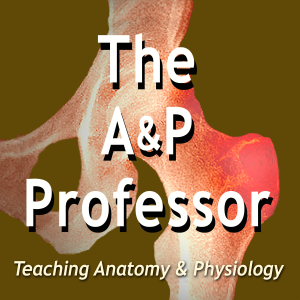
The A&P Professor
Education Podcasts
Explore human anatomy and physiology (A&P) teaching and learning with host Kevin Patton. An experienced professor, textbook author, and mentor, Kevin is a recognized leader in A&P teaching. The A&P Professor updates science content and provides practical teaching advice. Want some ideas to supercharge your A&P course? How about some support from a fellow A&P professor? This is the podcast for you!
Location:
United States
Genres:
Education Podcasts
Description:
Explore human anatomy and physiology (A&P) teaching and learning with host Kevin Patton. An experienced professor, textbook author, and mentor, Kevin is a recognized leader in A&P teaching. The A&P Professor updates science content and provides practical teaching advice. Want some ideas to supercharge your A&P course? How about some support from a fellow A&P professor? This is the podcast for you!
Twitter:
@theAPprofessor
Language:
English
Contact:
636-486-4185
Steve Sullivan on Teaching A&P Bit by Bit: Podcasts, Digital Learning, & Keeping It Human | TAPP 156
Duration:01:04:40
Dual Enrollment in A&P: Murray Jensen on Rigor, Pedagogy, and Community | TAPP 155
Duration:00:58:05
10 Reasons Why Mucus Is Our Friend | TAPP 154
Duration:00:28:31
Pulse Check: A Year in Review & What’s Next for A&P Teaching | TAPP 153
Duration:00:57:52
Fascinating Fascia: Kate Oland Galligan Unravels the Ties That Bind | TAPP 152
Duration:01:25:11
Muscling Through Barriers: The A&P Student Accommodations Handbook Unveiled | TAPP 151
Duration:01:06:01
Textbooks to Slides: IP Attorney Brenda Ulrich on Legal Image Use in Anatomy & Physiology | TAPP 150
Duration:01:16:16
Examining the Anatomy & Physiology Exam: Chatting with Greg Crowther and Ben Wiggins | TAPP 149
Duration:01:03:48
Blueprints for Learning: Justin Shaffer on Structured A&P Course Design | TAPP 148
Duration:00:53:53
Pulse of Progress: Looking Back, Moving Forward | TAPP 147
Duration:02:00:29
Anatomy of Trust: Promoting Integrity in A&P Education | Winter Shorts | TAPP 146
Duration:00:40:03
A Tongue Twister's Guide to Mastering Anatomy Pronunciation | Winter Shorts | TAPP 145
Duration:00:21:59
Dissecting the Kenhub Atlas: Insights from Editor Mike Pascoe | TAPP 144
Duration:00:50:06
The One Teaching Strategy That Will Fix Your Anatomy & Physiology Course | TAPP 143
Duration:00:52:08
Muscle: A Gripping Story by Roy Meals | TAPP 142
Duration:00:40:27
Study Courses Supercharge Anatomy & Physiology Success | TAPP 141
Duration:01:17:30
Pre-A&P: A Refresher for Student Success in Anatomy & Physiology | TAPP 140
Duration:01:24:02
Thinking New Thoughts about the Human Brain | TAPP 139
Duration:00:37:38
Dancing Organelles, AI Resources, Distracting Animations, Timed Tests & Micro-credentials | TAPP 138
Duration:00:46:17
Our Teaching Persona in Anatomy & Physiology Class | TAPP 137
Duration:00:50:20
